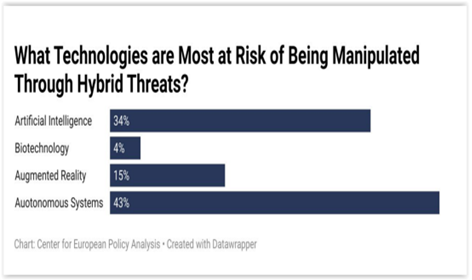
15 Jul Artificial intelligence as a tool for generating hybrid-based treats
Artificial intelligence (AI) is the human-like intelligence exhibited by machines or software, as a field of scientific research (also called machine intelligence in the beginning) is almost as old as electronic computers are.
New technologies, such as “Artificial Intelligence” and “big data” analysis, can be beneficial, for example, to quickly detect and counter fake news campaigns on the internet. However, they can also offer a potential aggressor an effective means for disruption or diversion as part of a hybrid campaign.[1] The use of AI for security can be a double-edged swart.
The technological advancements in AI have increasing implications for the cyber domain. Cyberattacks can become more cost-efficient as AI is incorporated into tasks currently performed by people. This will enable a growing number of actors to carry out attacks at an increasing speed, toward an increasing number of targets.
Use of AI for generating propaganda and disinformation
There are, signals that AI-enabled computational propaganda and disinformation are beginning to be used. Hackers and other groups have already begun testing the effectiveness of more dangerous AI bots over social media.
A 2017 piece from Gizmodo reported that two data scientists taught artificial intelligence to design its phishing campaign: “In tests, the artificial hacker was substantially better than its human competitors, composing and distributing more phishing tweets than humans, and with a substantially better conversion rate

Figure 1: What technologies are most at risk of being manipulated through hybrid threats
Artificial intelligence could be deployed by dictators, criminals and terrorists to manipulate elections and use drones in terrorist attacks, misusing the technology.
The common practice of AI use, for example, of “phishing” sending emails seeded with malware [3], targeted propaganda along with cheap, highly believable fake videos have become powerful tools for manipulating public opinion “on previously unimaginable scales” [4]
Author(s): Military Academy “General Mihailo Apostolski” – Skopje, Republic of North Macedonia
References:
[1] Bogatinov D, Bogdanoski M, Angelevski S. AI-based cyber defense for more secure cyberspace. In Handbook of research on civil society and national security in the era of cyber warfare 2016 (pp. 220-237). IGI Global.
[2] Hybrid Warfare of the Future: Sharpening NATO’s Competitive Edge, Available from: https://cepa.org/wp-content/uploads/2021/07/Hybrid-futures-two-pager-v2.pdf [Accessed 28 March 2022].
[3] Basit A, Zafar M, Liu X, Javed AR, Jalil Z, Kifayat K. A comprehensive survey of AI-enabled phishing attacks detection techniques. Telecommunication Systems. 2021 Jan;76(1):139-54.
[4] Kertysova K. Artificial intelligence and disinformation: How AI changes the way disinformation is produced, disseminated, and can be countered. Security and Human Rights. 2018 Dec 12;29(1-4):55-81.




